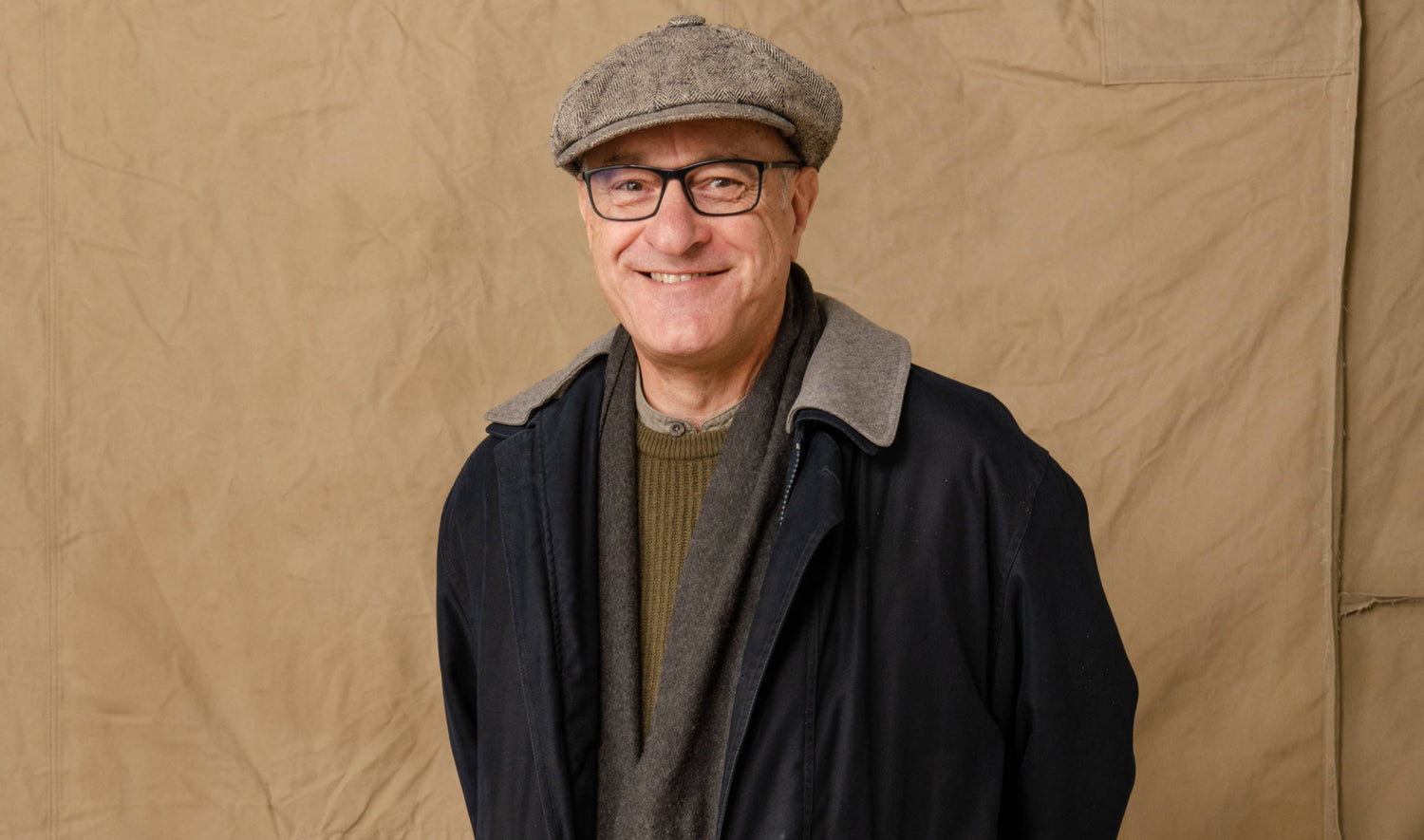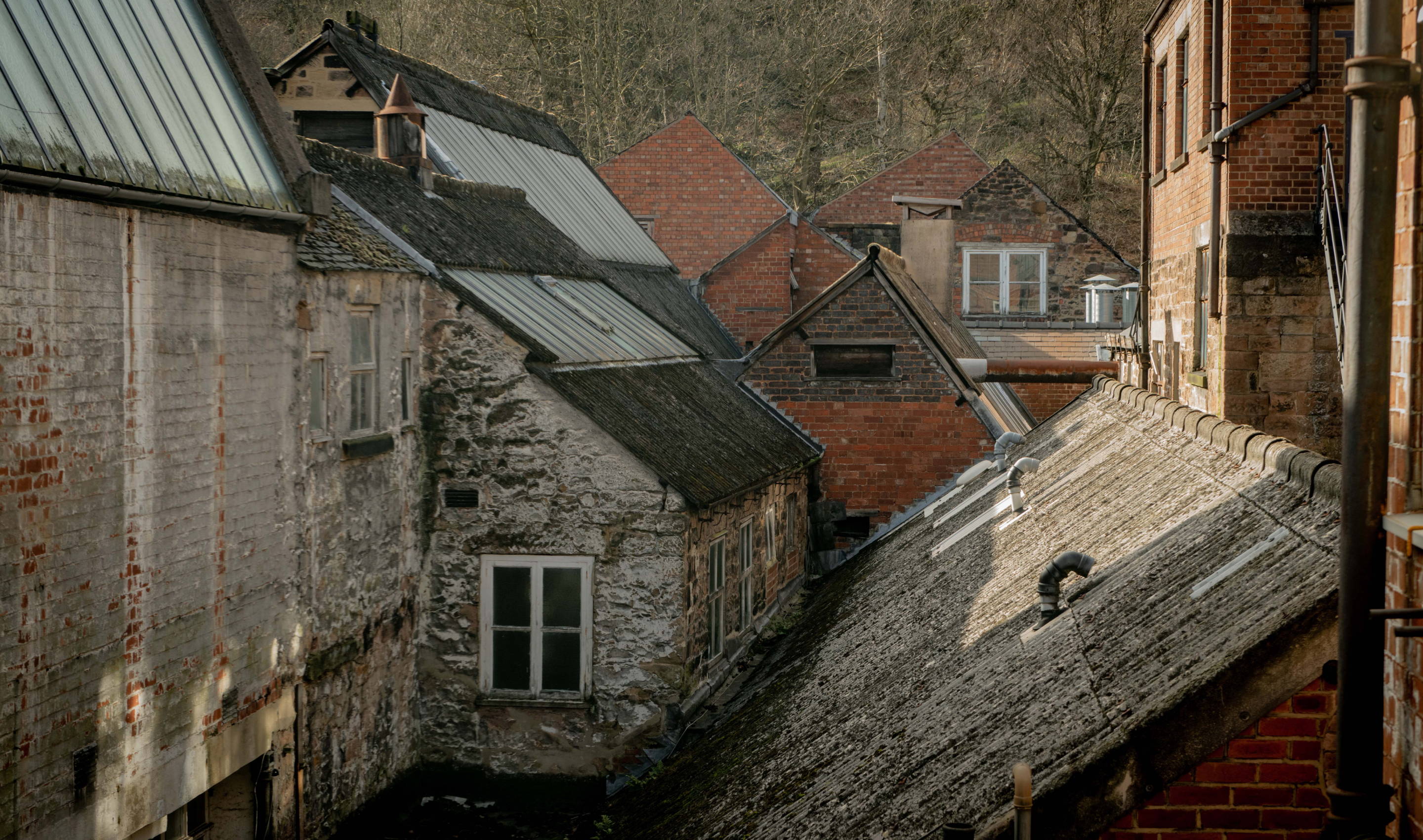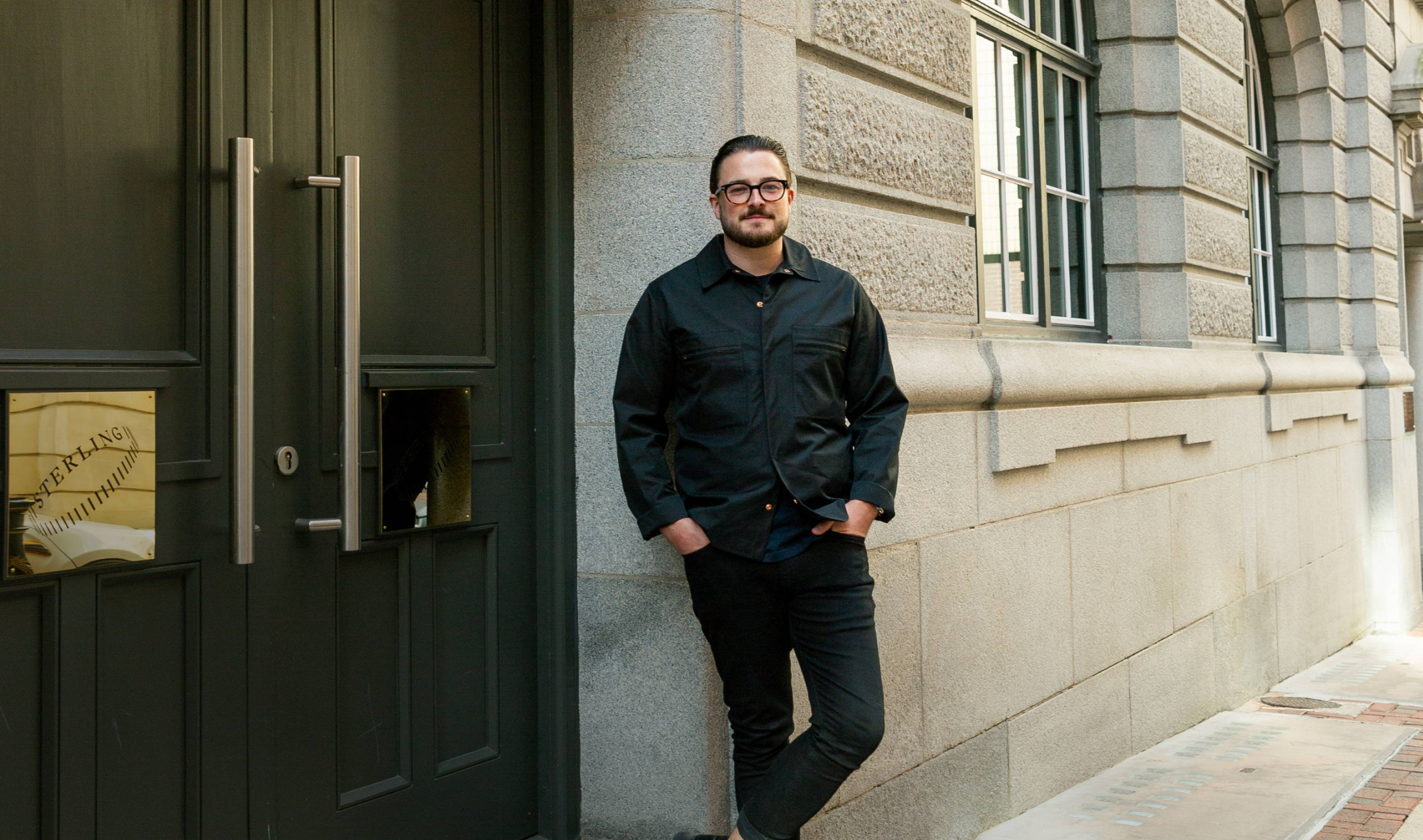Time To Read: 11 Minutes
Words by Meghann Thorp
An integral step whenever we are developing any product is to lean into our greatest asset, Mike Stoll (aka ‘Stolly’), father of three, beloved grandpa of eleven and now thrusting forward into his 51st year at the factory.
With half a century now under his belt (British-made of course), Stolly proudly asserts that his career which he has steadfastly dedicated to championing local manufacturing is “is beyond what I ever dreamed of when I started.”
This week on The Journal, we caught up with Mike to discuss his career highlights and the secret to making Great British Luxury Clothing in his own factory.
Time To Read: 11 Minutes
Words by Meghann Thorp
An integral step whenever we are developing any product is to lean into our greatest asset, Mike Stoll (aka ‘Stolly’), father of three, beloved grandpa of eleven and now thrusting forward into his 51st year at the factory.
With half a century now under his belt (British-made of course), Stolly proudly asserts that his career which he has steadfastly dedicated to championing local manufacturing is “is beyond what I ever dreamed of when I started.”
This week on The Journal, we caught up with Mike to discuss his career highlights and the secret to making Great British Luxury Clothing in his own factory.
How did you start in the industry?
I started with an apprenticeship in manufacturing in March 1972. After a few weeks of carrying boxes around the factory, they put me on a flat-bed machine whilst I waited a year to go to Hollings Collings – I was too young to do anything else. Back then, college was three days a week and I worked every Sunday until my course finished in 1975 trying to master the art of pattern cutting.
I didn’t particularly excel at anything so I took myself to one of the guys that worked at the factory. He taught me how to trace a pattern. So instead of learning how to simply draft it, I learnt how to trace it which helped me develop my skills quicker. I knew I’d never make it as a pattern cutter, so I had to learn on my feet. It was really challenging, equally daunting but crucially so much fun.
How did you first come from starting as a machinist to running a factory?
I started compiling ladies tear outs from magazines as inspiration and suggested the factory let me make a selection of ladies garments - my father Alec (94 and showing no signs of slowing up), was making womenswear at the time while my factory was specialising in menswear. My aim was to do something that was different to the existing product mix and with a heightened sense of fashion and flare. My father’s factory was part of Waverley Weathercoats Ltd and in 1974, it opened a new factory in 1974 on Oldham Road.
It soon became short of work and so my father encouraged me do a bit of my own stuff and so off I went, knocking up samples determined to make my own way. I was told at the time that ”if I sold them, they’d let me make them and give me something for doing it”. So that’s how the fashion thing started. It really took off.
Who have you worked with over the decades?
His father was inclined to shut the business down, but in my youthful naivety, I suggested we could take it over and so I started Drizzle Ltd which was my rainwear inspired trading company that would soon absorb Candy Fashions. With Drizzle gaining momentum, we started making menswear and ladieswear together, and were always scouring the region and country for different opportunities. One of those which came along for us was a licensing deal with Hardy Amies and House Of Fraser.
Then we started making pieces for the likes of Cricket, which was Nigel Cabourn’s first designing endeavor. A couple of years later through my good friend, (jersey jedi) Andrew Shane, I was introduced to Paul Smith who he had helped to buy the R. Newbold factory in Nottingham.
Following that, a flood of different designers came along, some who made it, some who didn’t. Reiss were around in the 1980’s as well as Ted Baker. Then there were people like Amanda Wakeley in the 90’s. On the ladies side, Robert Carey Williams made a name for himself, which led me onto doing our own brand with Emma Hartley which we sold into Harrods and Selfridges & Co. We started the Emma Hartley clothes shop with The Observer, doing a lot of full-page offers with designer names and magazines like Women’s Realm and Women’s Journal. Joe Casey-Hayford with Elle was also popular.
It was through those opportunities I eventually got working with Stella McCartney in the 1990’s as well as Margaret Howell. I was soon approached to take the licence for Griffin and run it as a brand. To this day I still have the article “The Time Is Right For Griffin” from 1st September 1996 framed and proudly displayed in my office. It’s a great article and a very proud moment in my career.
By the time the 2000’s came I was doing something slightly different. I was making coats for the likes of Burberry, Barbour and Mulberry. I did all the airlines as well, 15 altogether, as well as uniforms for the Met Police, gas suits for the gulf war and for the past 13 years I have been developing our own vertically integrated luxury brand, Private White V.C. with my partner James.
I’ve done a hell of a lot, that’s my story in a nutshell.
How did you start in the industry?
I started with an apprenticeship in manufacturing in March 1972. After a few weeks of carrying boxes around the factory, they put me on a flat-bed machine whilst I waited a year to go to Hollings Collings – I was too young to do anything else. Back then, college was three days a week and I worked every Sunday until my course finished in 1975 trying to master the art of pattern cutting.
I didn’t particularly excel at anything so I took myself to one of the guys that worked at the factory. He taught me how to trace a pattern. So instead of learning how to simply draft it, I learnt how to trace it which helped me develop my skills quicker. I knew I’d never make it as a pattern cutter, so I had to learn on my feet. It was really challenging, equally daunting but crucially so much fun.
How did you first come from starting as a machinist to running a factory?
I started compiling ladies tear outs from magazines as inspiration and suggested the factory let me make a selection of ladies garments - my father Alec (94 and showing no signs of slowing up), was making womenswear at the time while my factory was specialising in menswear. My aim was to do something that was different to the existing product mix and with a heightened sense of fashion and flare. My father’s factory was part of Waverley Weathercoats Ltd and in 1974, it opened a new factory in 1974 on Oldham Road.
It soon became short of work and so my father encouraged me do a bit of my own stuff and so off I went, knocking up samples determined to make my own way. I was told at the time that ”if I sold them, they’d let me make them and give me something for doing it”. So that’s how the fashion thing started. It really took off.
Who have you worked with over the decades?
His father was inclined to shut the business down, but in my youthful naivety, I suggested we could take it over and so I started Drizzle Ltd which was my rainwear inspired trading company that would soon absorb Candy Fashions. With Drizzle gaining momentum, we started making menswear and ladieswear together, and were always scouring the region and country for different opportunities. One of those which came along for us was a licensing deal with Hardy Amies and House Of Fraser.
Then we started making pieces for the likes of Cricket, which was Nigel Cabourn’s first designing endeavor. A couple of years later through my good friend, (jersey jedi) Andrew Shane, I was introduced to Paul Smith who he had helped to buy the R. Newbold factory in Nottingham.
Following that, a flood of different designers came along, some who made it, some who didn’t. Reiss were around in the 1980’s as well as Ted Baker. Then there were people like Amanda Wakeley in the 90’s. On the ladies side, Robert Carey Williams made a name for himself, which led me onto doing our own brand with Emma Hartley which we sold into Harrods and Selfridges & Co. We started the Emma Hartley clothes shop with The Observer, doing a lot of full-page offers with designer names and magazines like Women’s Realm and Women’s Journal. Joe Casey-Hayford with Elle was also popular.
It was through those opportunities I eventually got working with Stella McCartney in the 1990’s as well as Margaret Howell. I was soon approached to take the licence for Griffin and run it as a brand. To this day I still have the article “The Time Is Right For Griffin” from 1st September 1996 framed and proudly displayed in my office. It’s a great article and a very proud moment in my career.
By the time the 2000’s came I was doing something slightly different. I was making coats for the likes of Burberry, Barbour and Mulberry. I did all the airlines as well, 15 altogether, as well as uniforms for the Met Police, gas suits for the gulf war and for the past 13 years I have been developing our own vertically integrated luxury brand, Private White V.C. with my partner James.
I’ve done a hell of a lot, that’s my story in a nutshell.
During your career you’ve flown the flag for British Manufacturing, why is this so important to you?
I figured out very early on that my workers were the customers in the shops, the people that bought my products. I didn't want to see them out of work and I believed passionately that there would be a problem if the government carried on importing the way they were. I also thought from an economic point of view that it couldn’t last, eventually the money would run out. If I bought the factories, I would be in pole position for the inevitable comeback. Unfortunately, I was wrong – the cycle took a lot longer than I believed it would at the time.
If I was selling a coat at £9, the retail price was £19.99, so I’d double the price. Back in the 80’s companies were working on a much higher mark up. They were buying a coat at £9 and selling it at £99 but buying it from further afield. It took a long time for the money to drop. They were buying and selling commodities. The money wasn’t leaving the country, it was leaving in small drips. It’s only really accelerated in the last 20 years. I was right but delayed by about 30 years.
What’s been your career highlight?
The indoor and outdoor fashion shows I did with Griffin in the 90’s when we went to Paris were phenomenal. I’ve still got the video tape recordings.
But if I’m being completely honest, opening the shop in Mayfair with Private White and James is still my proudest moment - seeing all our own stock on display, it was fabulous.
What are the challenges of working with rainwear and outerwear?
The biggest challenge in manufacturing is making it practical. You do that by knowing what you’re doing - with years of knowledge. You learn the difference between virgin wool and recycled wool – one keeps the wind out and keeps you warm and one doesn’t, no matter how thick it is.
What makes our garments stand out from others?
The time-served history of people learning the trade over a long, long period. People learning from those who have the right skills, we’re not starting fresh all the time. It’s about continuity and knowledge.
What’s your favourite piece from the AW collection and why?
I like the peacoat because the fabric is so well developed, the style is so well developed and the pockets are so beautifully placed. The style is elegant and sophisticated.
During your career you’ve flown the flag for British Manufacturing, why is this so important to you?
I figured out very early on that my workers were the customers in the shops, the people that bought my products. I didn't want to see them out of work and I believed passionately that there would be a problem if the government carried on importing the way they were. I also thought from an economic point of view that it couldn’t last, eventually the money would run out. If I bought the factories, I would be in pole position for the inevitable comeback. Unfortunately, I was wrong – the cycle took a lot longer than I believed it would at the time.
If I was selling a coat at £9, the retail price was £19.99, so I’d double the price. Back in the 80’s companies were working on a much higher mark up. They were buying a coat at £9 and selling it at £99 but buying it from further afield. It took a long time for the money to drop. They were buying and selling commodities. The money wasn’t leaving the country, it was leaving in small drips. It’s only really accelerated in the last 20 years. I was right but delayed by about 30 years.
What’s been your career highlight?
The indoor and outdoor fashion shows I did with Griffin in the 90’s when we went to Paris were phenomenal. I’ve still got the video tape recordings.
But if I’m being completely honest, opening the shop in Mayfair with Private White and James is still my proudest moment - seeing all our own stock on display, it was fabulous.
What are the challenges of working with rainwear and outerwear?
The biggest challenge in manufacturing is making it practical. You do that by knowing what you’re doing - with years of knowledge. You learn the difference between virgin wool and recycled wool – one keeps the wind out and keeps you warm and one doesn’t, no matter how thick it is.
What makes our garments stand out from others?
The time-served history of people learning the trade over a long, long period. People learning from those who have the right skills, we’re not starting fresh all the time. It’s about continuity and knowledge.
What’s your favourite piece from the AW collection and why?
I like the peacoat because the fabric is so well developed, the style is so well developed and the pockets are so beautifully placed. The style is elegant and sophisticated.
Can you tell us about the Archive – what's in there and why is it so important?
The Archive is my ‘happy place’, my sanctuary that offers so many memories from every different era of design, development and culture. It’s the foundation that allows us to perfect the perfect peacoat or the very best raincoat. Over the years I have made hundreds and thousands of garments and so I have kept a hard copy of the very best. That’s why it’s such a great place. You can never remember a garment by looking at a picture, it’s not the same as touching it or feeling the fabric. The Archive started with 20 coats and 40 patterns, now there are over 11,000 patterns and probably close to 25,000 garments inside.
You pride yourself on being a father of 3 and grandpa of 11, is your family your greatest achievement?
I think the point of working is to provide for your family. That’s the real deal. You’ve got to love your work but you’ve got to love your family more than work otherwise you become a very sad individual. Work finishes in the end, but family goes on beyond you. My plans for the future? To wind down, travel to Antartica to see the emperor penguins and to give back as much as I possibly can while I’m still working. Watching people in the team like Alessia, yourself and Amy develop gives me a lot of joy, passing along the odd nugget of information and supporting in any way I can. The real aim is helping James to reach for the stars, it’s what the last 15 years has been all about.
THE MIKE'S AW22 TOP PICKS
Can you tell us about the Archive – what's in there and why is it so important?
The Archive is my ‘happy place’, my sanctuary that offers so many memories from every different era of design, development and culture. It’s the foundation that allows us to perfect the perfect peacoat or the very best raincoat. Over the years I have made hundreds and thousands of garments and so I have kept a hard copy of the very best. That’s why it’s such a great place. You can never remember a garment by looking at a picture, it’s not the same as touching it or feeling the fabric. The Archive started with 20 coats and 40 patterns, now there are over 11,000 patterns and probably close to 25,000 garments inside.
You pride yourself on being a father of 3 and grandpa of 11, is your family your greatest achievement?
I think the point of working is to provide for your family. That’s the real deal. You’ve got to love your work but you’ve got to love your family more than work otherwise you become a very sad individual. Work finishes in the end, but family goes on beyond you. My plans for the future? To wind down, travel to Antartica to see the emperor penguins and to give back as much as I possibly can while I’m still working. Watching people in the team like Alessia, yourself and Amy develop gives me a lot of joy, passing along the odd nugget of information and supporting in any way I can. The real aim is helping James to reach for the stars, it’s what the last 15 years has been all about.






Leave a comment
This site is protected by hCaptcha and the hCaptcha Privacy Policy and Terms of Service apply.